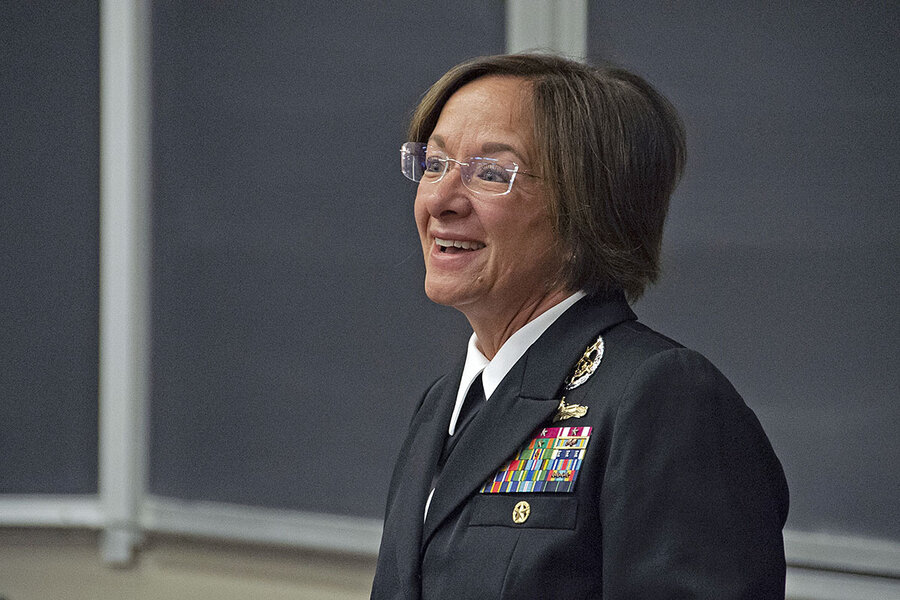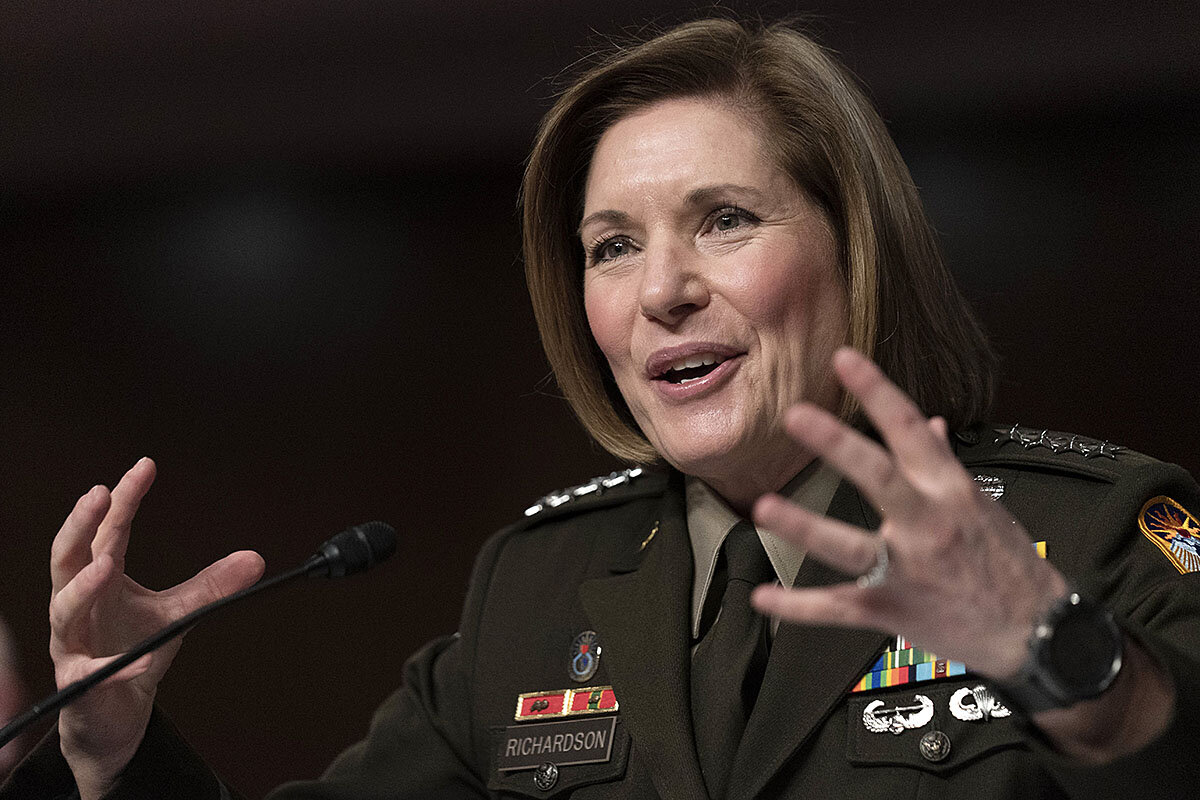US military’s top-brass women got together. Here’s what they said.
Loading...
Shortly after Lisa Franchetti joined the Navy in 1985, she stepped aboard her first ship and learned where she stood in the eyes of her boss, the ship’s chief engineer.
He said, “‘I don’t think you should be here, and I think I’m going to make sure you fail,’” the now-admiral recalled this month. “For me, it was pretty eye-opening that someone would say that.”
At the time, there were only 17 ship billets open to women in the Navy, and she’d worked hard to get one of them.
Why We Wrote This
A story focused onThe U.S. military’s four top-ranking women gathered recently for a rare moment on the same stage. They recounted discrimination, but also the positive impact – and growing welcome – of female troops.
When her colleagues heard about the run-in, however, they rallied around her “to make sure that didn’t happen,” she said. “We basically made it look like he was the failure for not wanting [women] to be there.”
Since last September, Admiral Franchetti has been the vice chief of naval operations, the nation’s second-highest ranking naval officer and the second woman to serve in that position. (Adm. Michelle Howard was the first Black woman – and the first woman ever – to serve as the vice chief, as well as the first woman ever to achieve a four-star rank in the Navy.)
Admiral Franchetti gathered earlier this month with the U.S. military’s most senior women, including three other four-star generals and admirals. It was the first time those four had ever shared a stage (a welcome dinner the night before was the first time they’d been in the same room together).
In the history of the American military, hundreds of men have attained the rank of four-star general or admiral, but only 10 women have done the same.
Half of them – including some pioneering four-star female colleagues who have since retired – gathered at the Military Women’s Memorial in Arlington, Virginia, this March during Women’s History Month to reflect on their careers and swap stories and advice they’d gleaned in their decades of service, with an auditorium full of young troops and older mentors.
During that time, there have been immense “changes in law, in policy, in culture that enabled all of us to be here today – I think it’s the honor of a lifetime to be a witness to this,” Admiral Franchetti said.
“And I think all of us have been part of the history – and had the opportunity to pay it forward a little bit.”
“You shouldn’t be here”
Air Force Gen. Jacqueline Van Ovost, too, recalled the early resistance she encountered upon her arrival at F-15 pilot school, soon after Pentagon regulations changed to allow women to fly fighter jets.
“One of the senior instructors pretty much said, ‘You shouldn’t be here,’” she recalled. “Of course, that was not my plan, and I was a little shocked.”
It took her “about a day” to recover, and after that, “I tell you what, I really leaned on my peers.” Her fellow male classmates “encouraged me. They said, ‘You have every right to be here. You’re a great pilot. You can wax people, and we’re going to help you.’”
And they did. Up to that point, General Van Ovost had flown heavy planes and had yet to learn basic fighter jet maneuvers, she said. Her classmates worked with her to ensure that “the next time I flew with or against this person” – the senior instructor – “I was ready to wax him.”
As they’ve steadily risen through the ranks, the women say they rarely experienced the naked disdain they encountered early in their careers – though there have been present-day moments that have given them pause.
Adm. Linda Fagan, who became the commandant of the Coast Guard last year, recalled experiencing a scene recognized by women across professions when sitting in a meeting full of men recently.
“This has happened – not in the last 18 months, but in the last two years – in a room full of very senior people, mostly white male senior people: They’re going around the table asking for perspective on a topic, and it’ll come to me, and I’ll say something. And there’s just sort of a nod, and they go around, and then two people later, the same thing gets said and they go, ‘Oh, that’s a great idea!’ And it’s like, ‘I just said that!’”
Now that she’s the Coast Guard’s top-ranking officer and the first woman ever to command a U.S. military service, “All of a sudden I’ve become very smart, very funny,” she said. “And it’s like, ‘Wow, how did that happen?’”
Army Gen. Laura Richardson, who currently heads up U.S. Southern Command, said she’s learned through the years that it’s helpful to do some “shaping” and “influencing” behind the scenes before presenting any big idea in any big meeting.
“You have those alliances, so when you do bring it up, you can count on those reinforcements who have already processed it and agreed with you that it’s a good idea,” she told the audience. “That’s what’s good about us – we know how to do that.”
A long way to go
In each of their three-plus decades of service, they have seen significant change for the better. But they acknowledge the military still has “a long way to go” in areas like preventing sexual harassment and assault. Some 8.4% of military women were sexually assaulted on the job during their service, according to a 2022 Pentagon report.
“All of the services have been on a journey around sexual harassment, sexual assault, bullying,” Admiral Fagan said, adding that she believes the trajectory, compared with a decade ago, is positive. “I would not have encouraged my daughter” – now a Coast Guard lieutenant – “to come in if I didn’t believe we could get this done.”
At heart, the obstacles that women in the military continue to face go “back to women being accepted, versus being included,” General Van Ovost said.
“If we were fully included, we would have armor that is built for a woman’s body based on how we carry the weight of equipment. We’d have flight suits that would fit us.”
Admiral Franchetti for her part considered getting out of the Navy early in her career while on shore duty. “I thought, ‘I don’t really like this.’” She was living in southern Oregon, taking classes in massage therapy. “I was definitely on my way out of the Navy,” she said.
Her father counseled her to think about her choice. “So I got a ‘What Color Is Your Parachute?’ book, and I forced myself to sit down at lunch every day and do the workbook,” she said. “What it came down to was the Navy had everything I wanted.”
As they have reached the highest ranks of their services, they are endeavoring, they stressed, to make the U.S. military better for those who follow in their footsteps.
It’s “incumbent upon us as leaders” to encourage tough conversations and foster diversity in the ranks, said General Van Ovost, who now leads U.S. Transportation Command. If everyone “walks and talks and looks like you – and is an academy grad sitting at that table – you’re not getting the best advice.”
And once folks are at the table, they have to make sure they speak, too, she added.
“Use your voice. Don’t presume that the others sitting at the table have your perspective,” Admiral Fagan said. “You’re not there by accident. It’s not random. It’s not luck. You’ve earned your way into the room.”









